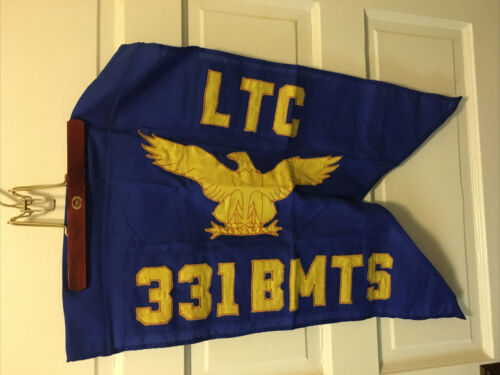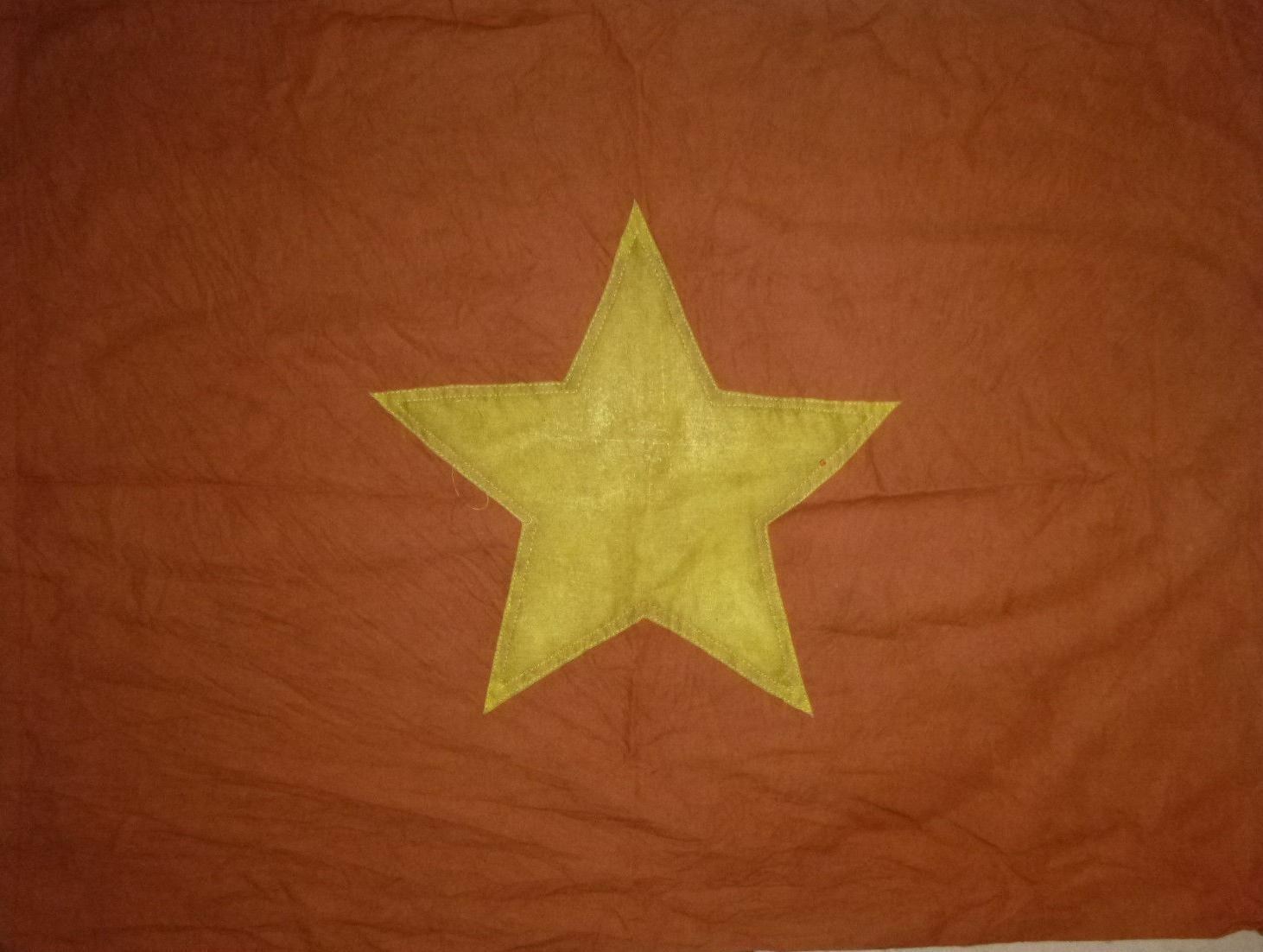-40%
FLAG - Viet Cong - TET 1968 - VC, NLF - CAM RANH AIR BASE - Vietnam War - 9718
$ 47.52
- Description
- Size Guide
Description
Viet Cong Battle Flag - Car Flag - Viet CongNational Liberation Front - Car Flag - House Flag - Battle Flag
NVA - VC - NLF - National Front For the Liberation of South Vietnam
CAM RANH - CAM RANH BAY - CAM RANH AIR FORCE BASE
Excellent War Piece - Original - Excellent Condition
Measures - 29 x 21 inches (75 x 54 cms)
Excellent Piece
NLF, NVA, VC - Viet Cong / National Liberation Front
Cam Ranh Bay – Combat Base – Air Base
Cam Ranh Air Force Base is located on Cam Ranh Bay in Khánh Hòa Province, Vietnam. It was one of several air bases built and used by the United States Air Force (USAF) during the Vietnam War.
Cam Ranh Air Force Base was part of the large Cam Ranh Bay logistics facility built by the United States. It was the major military seaport used by the United States for the offloading of supplies, military equipment and as a major Naval base.
Army, Navy, Marine Corps and Air Force units all had compounds and units assigned to the Cam Ranh Bay facility from its opening in 1965 until its closure in 1972 as part of the drawdown of United States military forces in South Vietnam.
Between 1979 and 2002, the facility was used by the Soviet Navy and then Russian Navy. At the end of 2013, Russia resumed the use of the base by its Navy and in 2014 by its Air Force.
On 19 May 2004, after major reconstruction, Cam Ranh Airport received its first commercial flight. As Vietnam considers the facility to be important to its defense, a small garrison of troops are stationed there.
In April 1965 CINCPAC instructed an engineering survey for a new airfield at Cam Ranh Bay.
In mid-1965, the American construction consortium RMK-BRJ was directed by the Navy Officer in Charge of Construction RVN (OICC RVN) to construct a new airfield at Cam Ranh Bay, starting with a temporary 10,000-foot (3,000 m) runway consisting of 2.2 million square feet (200,000 square meters) of AM-2 aluminum matting to accommodate jet fighter-bombers.
By September, RMK-BRJ had employed 1,800 Vietnamese workers for the work, over half of whom were women.
The runway was completed in 50 days, with Admiral U.S.G. Sharp, CINCPAC, laying the last AM-2 plank on 16 October 1965.
The airfield was opened for U.S. Air Force operations on 1 November 1965.
A 1.3 million square feet (120,000 square meters) cargo apron using pierced steel planking, airport facilities and utilities, mess halls, and 25,000 square feet (2,300 square meters) of living quarters were also prepared for use by the USAF.
By the end of 1966, RMK-BRJ and OICC RVN completed construction of an additional 10,000-foot (3,000 m) concrete runway and taxiway at the air base.
Once the concrete runway was built, the original AM-2 runway was to be removed and replaced with a new concrete runway.
In addition between June and September US Army engineers built fuel storage areas and 30 miles (48 km) of roads and lengthened the pier before handing over the work to RMK-BMJ.
In July 1965 it was planned that 3 fighter squadrons would be deployed to Cam Ranh Air Base once it was completed in October.
On 28 October 1965 an advance party of the 43rd Tactical Fighter Squadron arrived at the base, the squadron equipped with F-4C Phantom II fighter-bombers arrived on 1 November and began flying missions over South Vietnam the following day.
Beginning on 1 January 1972, the USAF phased down its activities, and active flying ended by 31 March.
Cam Ranh Air Base was turned over to the South Vietnamese government on 15 May 1972, ending USAF use of the facility.
After the turnover to the South Vietnamese the base was largely abandoned. It was, quite simply, much too big for the Vietnamese to use. The base was slowly looted for its usable equipment, such as air conditioners, desks, refrigerators, and other furniture along with windows, doors and corrugated tin roofs from the buildings left by the Americans, leaving what could be categorized as a deteriorating ghost town of abandoned buildings.
The Republic of Vietnam Air Force (RVNAF) used the airfield as a storage facility for many of their A-1 Skyraiders, while their replacement jet F-5s and A-37s were used in operations against the People's Army of Vietnam (PAVN) from other, smaller bases.
On 3 April 1975 the PAVN 10th Division advanced on Cam Ranh Bay and despite scattered resistance from the Army of the Republic of Vietnam and RVNAF airstrikes by 14:00 they had captured the entire base.
On Jan. 31, 1968, when 21-year-old Dean Dietrich's plane left Fort Lewis, Wash., bound for Vietnam, little did the soldier from Kutztown know that he was about to step into events that would someday be regarded as a milestone of history.
It would come to be known as the Tet Offensive, but as Dietrich's plane flew out over the Pacific that evening, chasing a setting sun across the international date line, nobody knew that a new phase of the war on the ground in Vietnam had begun.
Named for the Vietnamese New Year celebration that begins on Jan. 30, the Tet Offensive was under way when Dietrich landed.
"When I got there," remembers Dietrich, "they were blowing up the runways at Cam Ranh Bay." (The Morning Call, January 25th 1998)
30th of January 1968 – First Night of the Tet Offensive
Whether by accident or design, the first wave of attacks began shortly after midnight on 30 January as all five provincial capitals in II Corps and Da Nang, in I Corps, were attacked.
Nha Trang, headquarters of the U.S. I Field Force (FFI), was the first to be hit, followed shortly by Ban Mê Thuột, Kon Tum, Hội An, Tuy Hòa, Da Nang, Qui Nhơn, and Pleiku.
During all of these operations, the Viet Cong and North Vietnamese followed a similar pattern: mortar or rocket attacks were closely followed by massed ground assaults conducted by battalion-strength elements of the Viet Cong, sometimes supported by North Vietnamese regulars.
These forces would join with local cadres who served as guides to lead the regulars to the most senior South Vietnamese headquarters and the radio station.
The operations, however, were not well coordinated at the local level.
By daylight, almost all communist forces had been driven from their objectives.
General Phillip B. Davidson, the new MACV chief of intelligence, notified Westmoreland that "
This is going to happen in the rest of the country tonight and tomorrow morning."
All U.S. forces were placed on maximum alert and similar orders were issued to all ARVN units. The allies, however, still responded without any real sense of urgency. Orders cancelling leaves either came too late or were disregarded.
Viet Cong, VC, NLF
National Liberation Front
Super Rare Find, this piece made to be carried into battle or hung from car, often from truck aerials or attached to top of bamboo, hung in offices and from building.
NLF - National Liberation Front
The Việt Cộng, also known as the National Liberation Front (NLF), was a communist political organization with its own army – the People's Liberation Armed Forces of South Vietnam (PLAF) – in South Vietnam and Cambodia that fought the United States and South Vietnamese governments, eventually emerging on the winning side.
It had both guerrilla and regular army units, as well as a network of cadres who organized peasants in the territory it controlled. Many soldiers were recruited in South Vietnam, but others were attached to the People's Army of Vietnam (PAVN), the regular North Vietnamese army.
During the war, communists and anti-war activists insisted the Việt Cộng was an insurgency indigenous to the South, while the U.S. and South Vietnamese governments portrayed the group as a tool of Hanoi. Although the terminology distinguishes northerners from the southerners, communist forces were under a single command structure set up in 1958.
North Vietnam established the National Liberation Front on December 20, 1960, to grow insurgency in the South. Many of the Việt Cộng's core members were volunteer "regroupees", southern Việt Minh who had resettled in the North after the Geneva Accord (1954).
Hanoi gave the regroupees military training and sent them back to the South along the Ho Chi Minh trail in the early 1960s.
The NLF called for southern Vietnamese to "overthrow the camouflaged colonial regime of the American imperialists" and to make "efforts toward the peaceful unification".
The People's Liberation Armed Forces of South Vietnam (PLAF)'s best-known action was the Tet Offensive, a massive assault on more than 100 South Vietnamese urban centers in 1968, including an attack on the U.S. embassy in Saigon.
The offensive riveted the attention of the world's media for weeks, but also overextended the Việt Cộng. Later communist offensives were conducted predominantly by the North Vietnamese. The organization was dissolved in 1976 when North and South Vietnam were officially unified under a communist government.
For your kind Consideration.
What you see is what you get
No Stock Photos used, No Substitutions
Command Control, North, South, Central, MACV, Special Forces, SOG, Special Op’s, Special Operations Group, 5 th Special Forces, Army Security Agency, Military Intelligence, Psy-Ops, US Army, De Oppresso Liber, Airborne, 1 st Special Forces, CIDG, Mike Force, Mobile Guerrilla Force, Mobile Strike Force, Operations Detachment, Provincial Recon Unit, Recon Teams, RT, USMC, United States Marine Corps, Vietnam War, WWII, WWI, French Indochine War, French Foreign Legion, Legion Etrange, Project Omega, Recondo School, Rapid Fire, Project Delta, Special Missions Advisory Force, Project Gamma, Project Sigma, Indigenous Troops, MACV-SOG, CCC, CCS, CCN, USARV, SMAG, TAG, Field Training Command, Recon Team Leader, US Navy, Air Force, AATTV, Long Tan, Nui Dat, AAFV, ATF, New Zealand V Force, Big Red One, 1st Infantry Division, 1st Cavalry Division, Tropic Lightning, 25th Infantry Division, Subdued, Patch, Patches, Uniform, Helmet, Flash, Beret, Arc, Tab, 101 st Airborne Division, 82nd Airborne, 173rd Airborne, Combat, Militaria, Medal, Badge, Map, 199th Infantry Brigade, Old Ironsides, 5th Infantry Division, MAAG, USARPAC, XXIV Corps, 23rd Infantry Division, Americal, 38th Infantry Division, Black Op’s, Clandestine, Non-Conventional Warfare, 11th Infantry Brigade, 11th Armored, 196th , 1st Aviation, 18th Engineers, Medic, Medical, Viet Cong, VC, Viet Minh, Dien Bien Phu, Saigon, Tiger Force Rangers, Ranger, Logistical Command, Khe Sanh, POW, RVN, ARVN, South Vietnam, North Vietnam, NVA, Hanoi, Siagon, Phan Rang, LLDB, Bright Light, Free World Forces, Company, Platoon, Patrol, Long Range, Special Forces, ARVN, Green Berets, Elite, Recon, Reconnaissance, CCN, CCC, CCS, MACV SOG, SOA, Paratrooper, Parachutist, Vietnam War, Special Operations, Military, Tiger, Ranger, Route, Team, VC, NVA, Viet Cong, Command Control, Republic of Vietnam, Assault Helicopter Company, Gunship, Spooky, US Air Forces














